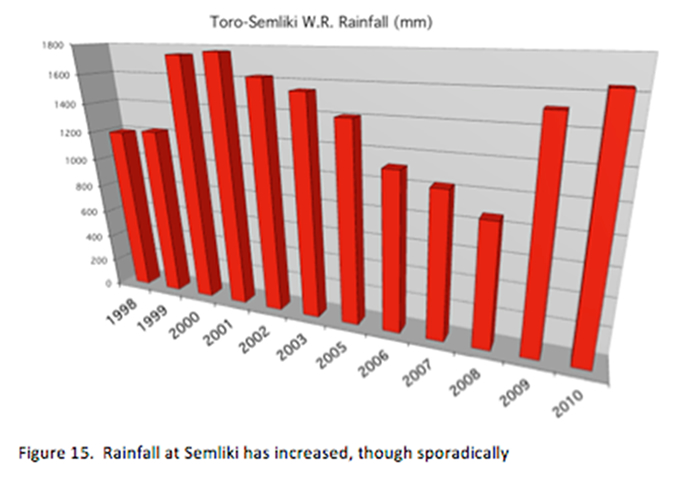[vc_row][vc_column width=”2/3″][vc_column_text]The Toro-Semliki climate is dry, particularly in comparison to sites where chimpanzees are found (Figure 14). Only Mount Assirik is drier than Semliki, though rainfall at Budongo, to the north of Semliki, is also quite low.
Historically, Toro-Semliki has had two distinct rainy and dry seasons; rainy seasons are March-May and August-November and dry seasons are June to July and December through February. Recently the distinction between dry and wet seasons has been less pronounced.

From the 1950s through the 70s rainfall at Semliki varied between 700 and 1300 mm (Pratt & Gwynne, 1977); SCP records for 1998 and 1999 were similar to earlier figures (Figure 15), at around 1200 mm, but recently rainfall increased, now averaging 1389 mm. Th entire Western Great Rift appears to have grown wetter (Plumptre, 2011).
Semliki is hot and humid. Daily maximum temperatures average 34 °C, and the mean daily minimum is 20 °C. Of chimpanzee study sites, only Assirik is hotter (Hunt and McGrew, 2002). Relative humidity daily maxima average 95% in the wet season and 92% in the dry season (Hunt et al., 1999).
Climate is strongly influenced by Lake Albert, but is also influenced by three other separate air masses (Verner and Jenik, 1978), that of the Rwenzori Mountains, the uplands to the east of the reserve, and the air mass associated with the Congolese rainforest to the west. The temperature of the lake is less variable than the air and soil, so that as the temperature drops at night, the warmer air over the lake rises, creating a prevailing wind toward the lake, or northeast. In the day the lake is typically cooler than surrounding areas, creating a prevailing wind away from the lake, or southwest (Verner and Jenik, 1978).[/vc_column_text][/vc_column][vc_column width=”1/3″][vc_widget_sidebar sidebar_id=”shop-widget”][/vc_column][/vc_row]